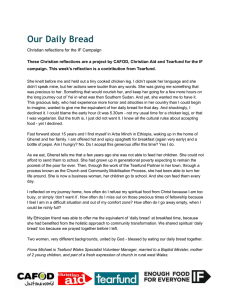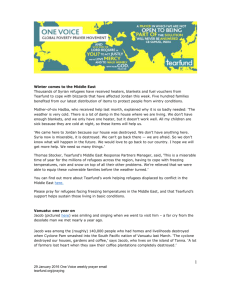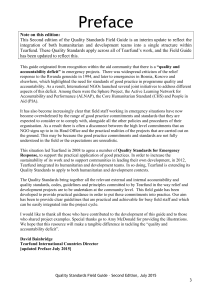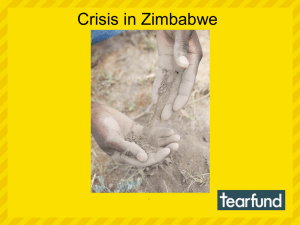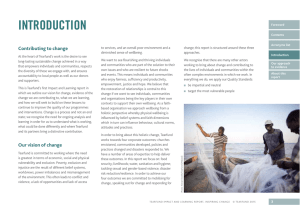FOOD SECURITY OUR CONTRIBUTION TO CHANGE PART TWO
advertisement
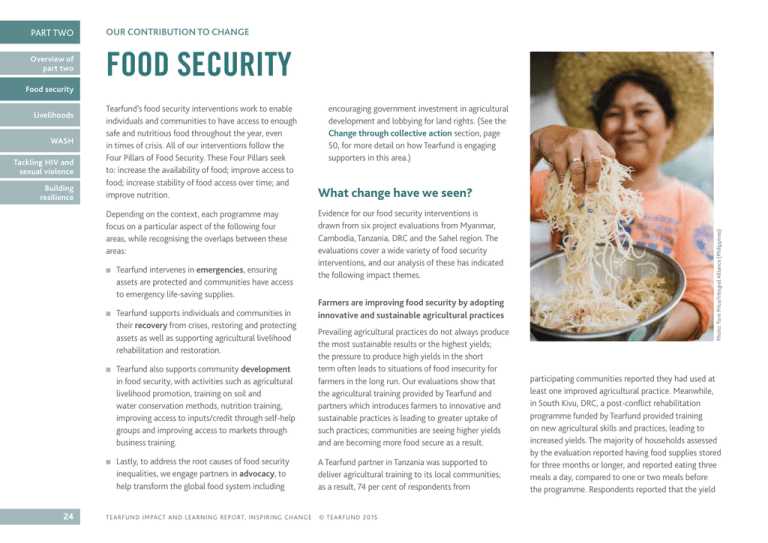
PART TWO OUR CONTRIBUTION TO CHANGE Overview of part two FOOD SECURITY Food security WASH Tackling HIV and sexual violence Building resilience Tearfund’s food security interventions work to enable individuals and communities to have access to enough safe and nutritious food throughout the year, even in times of crisis. All of our interventions follow the Four Pillars of Food Security. These Four Pillars seek to: increase the availability of food; improve access to food; increase stability of food access over time; and improve nutrition. Depending on the context, each programme may focus on a particular aspect of the following four areas, while recognising the overlaps between these areas: ■ ■ ■ ■ 24 Tearfund intervenes in emergencies, ensuring assets are protected and communities have access to emergency life-saving supplies. Tearfund supports individuals and communities in their recovery from crises, restoring and protecting assets as well as supporting agricultural livelihood rehabilitation and restoration. encouraging government investment in agricultural development and lobbying for land rights. (See the Change through collective action section, page 50, for more detail on how Tearfund is engaging supporters in this area.) What change have we seen? Evidence for our food security interventions is drawn from six project evaluations from Myanmar, Cambodia, Tanzania, DRC and the Sahel region. The evaluations cover a wide variety of food security interventions, and our analysis of these has indicated the following impact themes. Farmers are improving food security by adopting innovative and sustainable agricultural practices Tearfund also supports community development in food security, with activities such as agricultural livelihood promotion, training on soil and water conservation methods, nutrition training, improving access to inputs/credit through self-help groups and improving access to markets through business training. Prevailing agricultural practices do not always produce the most sustainable results or the highest yields; the pressure to produce high yields in the short term often leads to situations of food insecurity for farmers in the long run. Our evaluations show that the agricultural training provided by Tearfund and partners which introduces farmers to innovative and sustainable practices is leading to greater uptake of such practices; communities are seeing higher yields and are becoming more food secure as a result. Lastly, to address the root causes of food security inequalities, we engage partners in advocacy, to help transform the global food system including A Tearfund partner in Tanzania was supported to deliver agricultural training to its local communities; as a result, 74 per cent of respondents from T E A RF U ND IMPACT AND LEARN ING REPORT, I NSPI R ING CHA NGE © T EA R FUND 20 15 Photo: Tom Price/Integral Alliance (Philippines) Livelihoods participating communities reported they had used at least one improved agricultural practice. Meanwhile, in South Kivu, DRC, a post-conflict rehabilitation programme funded by Tearfund provided training on new agricultural skills and practices, leading to increased yields. The majority of households assessed by the evaluation reported having food supplies stored for three months or longer, and reported eating three meals a day, compared to one or two meals before the programme. Respondents reported that the yield OUR CONTRIBUTION TO CHANGE from their crops was two to four times that which they expected from the number of seeds planted; this was consistently attributed to the application of new agricultural practices learnt through the programme. Training on new practices was carried out using a comprehensive curriculum developed for the region and agreed with the Ministry of Agriculture (MoA). Follow-up was provided by Tearfund’s food security animators and MoA workers trained by the programme. Seed banks and home gardening initiatives are improving access to nutritious food The limited availability of healthy food is a common issue for poor communities who are often unable to grow vegetables throughout the year due to factors such as weather, accessibility of water and availability of seeds. Our evaluations show that, through seed distribution via seed banks, communities are able to grow new as well as existing varieties of vegetables. In South Kivu, DRC, project participants reported eating vegetables more frequently than before due to growing new and existing varieties of vegetables as a result of the seed distributions. A similar approach has been implemented by the Integrated Community Development Project (ICDP) in Cambodia, where communities have been trained in how to take care of home gardens and are now able to grow vegetables throughout the year. As a result, families are reported to have improved diets and lowered the cost of buying staples by growing their own crops. The home gardening approach enables families to grow vegetables all year round, rather than only in the rainy season. This is because home gardens require less water than fields, and water is more readily available near the home from the local well or by collecting waste water. In Myanmar, a Tearfund partner supported 307 families to practise home gardening in 2012; 90 per cent of them have increased food for family consumption. This approach was also encouraged as part of a project in Afghanistan, where communities were given vegetable gardening toolkits and vegetable cultivation training. Home gardens in Afghanistan were affected by drought and access to land, but the produce that was successfully grown was shown to supplement family diets and to promote healthy improvements in eating habits. Cаe S"# Improving food security in the Sahel food crisis, 2012 Africa’s Sahel region covers ten countries and is subject to changing climate, extreme floods and cyclical droughts. In 2012, the region was hit by a devastating food and livelihoods crisis. At its peak, the crisis affected an estimated 18 million people across nine countries. Tearfund partners began to respond in January 2012 before the peak of the crisis with disaster preparedness activities in Mali, Burkina Faso, Niger and Chad as these were the countries worst affected by the crisis and areas where Tearfund had existing partners on the ground. Tearfund’s timely response was successful in reducing the damage caused by the crisis, particularly with regard to food security. Tearfund partners distributed food to help families cope with the situation when there was a lack of food and to prevent the selling of assets including livestock which would have had devastating knock-on effects. PART TWO Overview of part two Food security Livelihoods Tearfund’s response Tearfund’s response focused on building resilience in food security; we had learnt from previous experience that food distributions alone are not enough and will not lead to sustainable outcomes. Therefore, in addition to food distributions for vulnerable community members, we gave support towards long-term activities, including market gardening and cash-for-work schemes. This not only contributed to increased agricultural yields in the participating communities but also provided increased access to income in the long term. WASH Tackling HIV and sexual violence Building resilience It was noted that communities had started working together more as a result of the interventions, using innovative techniques to overcome their daily challenges. In agriculture, this included using waterretaining bunds in the fields to slow down water loss, making natural fertilisers and letting seedlings mature for longer as well as trying out new varieties of seed. One village in Burkina Faso whose fields had flooded decided to start growing rice, an initiative that was not introduced by the project but indicates that the community was finding creative new ways to adapt to their circumstances. Food security between harvests is a key indicator of sustainability, and one method to ensure this is the use of cereal banks. Cereal banks contributed to food security across all four countries where Tearfund T EA R FUND I M PACT A ND L E AR NI N G R E P O RT, I N SP I R IN G C H AN GE © T E AR FU N D 201 5 25 Overview of part two Food security Livelihoods WASH Tackling HIV and sexual violence Building resilience OUR CONTRIBUTION TO CHANGE responded during the Sahel food crisis. However, the method proved to be challenging and could have been improved upon in some cases. For example, in Chad, a cereal bank was built by a Tearfund partner, but the evaluation found it was operating as a permanent grain store where community members could store their harvest for a small monthly fee; although their storage facility was an improvement on traditional grain stores, there was no management of the buying, stocking and selling of cereal during the hunger gap, so the cereal bank was ineffective despite the training given. Conclusion This case in Chad illustrates that in order for cereal banks to operate to their full potential, it is essential that partners have experience of implementing successful cereal banks before they are funded. It also highlights the importance of sharing learning between partners who have functioning cereal banks to ensure best practices are followed. This case also highlights the need for good start-up training and ongoing follow-up to ensure the bank is being used to its full purpose. Despite the overall underperformance of cereal banks in this case, a participant from Guilo village in Chad reflected on the changes she had seen in her community as a result of the project: ‘We have learnt to improve household management of food and resources; to not consume all the harvest immediately but to save it until bad times and look for other ways to make money. Now this year’s harvest can last until next year’s.’ 26 T E A RF U ND IMPACT AND LEARN ING REPORT, I NSPI R ING CHA NGE K! L"#$ The establishment of seed/cereal/ grain banks should be combined with appropriate training sessions on how to maximise the benefits of these initiatives ✓ Distribution of assets at a household or community level must be accompanied by training sessions on how to use and manage the asset in the future. This ensures that the community has the knowledge required for sustainable management of the initiative and is particularly important when systems need to be developed to ensure the longevity of the asset’s potential. The long-term impact of food distributions is enhanced when integrated with other sustainable interventions such as income-generating activity (IGA) loans and training ✓ This lesson reinforces the interconnectedness of food security and livelihoods. While in certain contexts, including humanitarian crisis situations, food distributions are necessary to meet immediate basic needs, the integration of these with training in sustainable agricultural practices or training for IGAs will improve long-term food security. Farmers’ transition to sustainable practices is a long-term process which requires behaviour change ✓ Tearfund and partners recognise that behaviour change in agricultural practices is a slow process which requires rigorous reinforcement, training and sharing of successes in order to build momentum. This is especially important when encouraging farmers to adopt sustainable low-input agricultural practices which are often counter to other higher-input practices being promoted by external agents and input suppliers. © T EA R FUND 20 15 Photo: Will Boase/Tearfund (Rwanda) PART TWO

